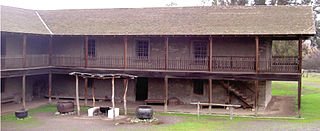
Juan Bautista de Anza was born in the Spanish Provence of New Navarre in Viceroyalty of New Spain. Of Basque descent, he served as an expeditionary leader, military officer, and politician primarily in California and New Mexico under the Spanish Empire. He is credited as one of the founding fathers of Spanish California and served as an official within New Spain as Governor of the Province of New Mexico.

Mission San Antonio de Padua is a Spanish mission established by the Franciscan order in present-day Monterey County, California, near the present-day town of Jolon. It was founded on July 14, 1771, and was the third mission founded in Alta California by Father Presidente Junípero Serra. The mission was the first use fired.tile roofing in Upper California. Today the mission is a parish church of the Diocese of Monterey.
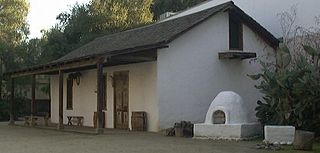
The Peralta Adobe is the oldest building in San Jose, northern California, still standing today. The adobe was built in 1797, and is named after Luis María Peralta, its most famous resident. The original builder was probably Manuel González.

The Las Flores Estancia was established in 1823 as an estancia ("station"). It was part of the Spanish missions, asistencias, and estancias system in Las Californias—Alta California. Las Flores Estancia was situated approximately halfway between Mission San Luis Rey de Francia and Mission San Juan Capistrano. It is located near Bell Canyon on the Camp Pendleton Marine Corps Base ten miles south of the City of San Clemente in northern San Diego County, California. The estancia is also home to the architecturally significant National Historic Landmark Las Flores Adobe, completed in 1868.

Tumacácori National Historical Park is located in the upper Santa Cruz River Valley in Santa Cruz County, southern Arizona. The park consists of 360 acres (1.5 km2) in three separate units. The park protects the ruins of three Spanish mission communities, two of which are National Historic Landmark sites. It also contains the landmark 1937 Tumacácori Museum building, also a National Historic Landmark.

El Presidio Real de Santa Bárbara, also known as the Royal Presidio of Santa Barbara, is a former military installation in Santa Barbara, California, USA. The presidio was built by Spain in 1782, with the mission of defending the Second Military District in California. In modern times, the Presidio serves as a significant tourist attraction, museum and an active archaeological site as part of El Presidio de Santa Barbara State Historic Park.

The Rancho San Andrés Castro Adobe is a historic house in California.
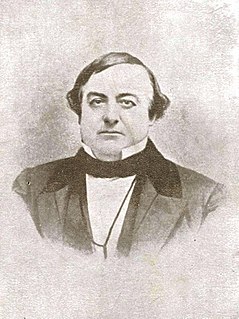
Juan Bautista Valentín Alvarado y Vallejo was a Californio and Governor of Las Californias from 1837 to 1842. In 1836, he led a coup that seized Monterey and declared himself governor, backed by other northern Californios, with help from Capt. Isaac Graham and his "Tennessee Rifles". Alvarado declared independence for California but, after negotiations with the territorial Diputación (Legislature), was persuaded to rejoin Mexico peacefully in exchange for more local autonomy. As part of the agreement, in 1837 he was appointed governor of Las Californias, and served until 1842.

Monterey State Historic Park is a historic state park in Monterey, California. It includes part or all of the Monterey Old Town Historic District, a historic district that includes 17 contributing buildings and was declared a National Historic Landmark in 1970. The grounds include California's first theatre, and the Monterey Customs House, where the American flag was first raised over California.
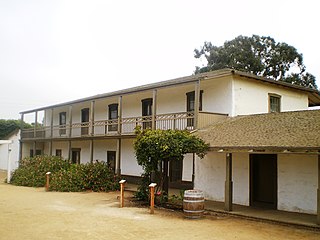
The Olivas Adobe in Ventura, California is an adobe structure built in 1841 by Raymundo Olivas on the north bank of the Santa Clara River about a mile from the estuary where it flows into the Santa Barbara Channel.

The Cathedral of San Carlos Borromeo, also known as the Royal Presidio Chapel, is a Roman Catholic cathedral located in Monterey, California, United States. The cathedral is the oldest continuously operating parish and the oldest stone building in California. It was built in 1794 making it the oldest serving cathedral along with St. Louis Cathedral in New Orleans, Louisiana. It is the only existing presidio chapel in California and the only existing building in the original Monterey Presidio.

José Antonio Castro was a Californio politician, statesman, and military leader who served as acting governor of Alta California in 1835. He was also Commandante General of Mexican forces in northern areas of Las Californias during the Bear Flag Revolt and the Mexican–American War of 1846–1848.
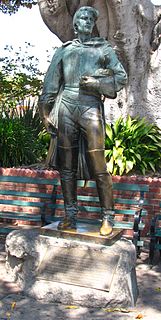
Felipe de Neve (1724–1784) was the fourth governor of Las Californias, a province of New Spain,from 1775 to 1782. Neve is considered a founder of Los Angeles, California and helped to settle towns of Santa Barbara and San José whose surrounding communities became California cities. In 1781, Neve issued the first rules regarding governance of secular pueblos like Los Angeles, the "Regulations for the Government of the Province of the Californias"
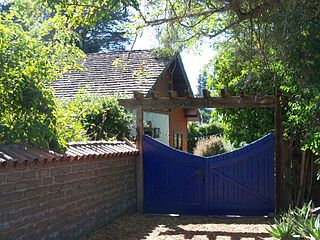
The Branciforte Adobe, also known as the Craig-Lorenzana Adobe, is the only remaining dwelling from the Villa de Branciforte, the settlement that was established in 1797 at the time of the Mission Santa Cruz.

The Juan de Anza House, also known as the Anza House, is a historic house at Franklin and Third Streets in San Juan Bautista, California, USA. Built about 1830, it is a well-preserved example of residential construction during California's Mexican period. As an architectural type example, it was declared a National Historic Landmark in 1970.

San Juan Bautista State Historic Park is a California state park encompassing the historic center of San Juan Bautista, California, United States. It preserves a significant concentration of buildings dating to California's period of Spanish and Mexican control. It includes the Mission San Juan Bautista, the Jose Castro House, and several other buildings facing the historic plaza. It became a state park in 1933 and was declared a National Historic Landmark in 1970. It is also a site on the Juan Bautista de Anza National Historic Trail.

San Estevan del Rey Mission Church is a Spanish mission church on the Acoma Pueblo Reservation in western New Mexico. Built between 1629 and 1641, it is one of the finest extant examples of hybrid Spanish Colonial and Puebloan architectural styles. It was named for Saint Stephen I of Hungary. The church was declared a National Historic Landmark in 1970, and is listed on the National Register of Historic Places.

The Larkin House is a historic house at 464 Calle Principal in Monterey, California. Built in 1835 by Thomas O. Larkin, it is claimed to be the first two-story house in all of California, with a design combining Spanish Colonial building methods with New England architectural features to create the popular Monterey Colonial style of architecture. The Larkin House is both a National and a California Historical Landmark, and is a featured property of Monterey State Historic Park.


